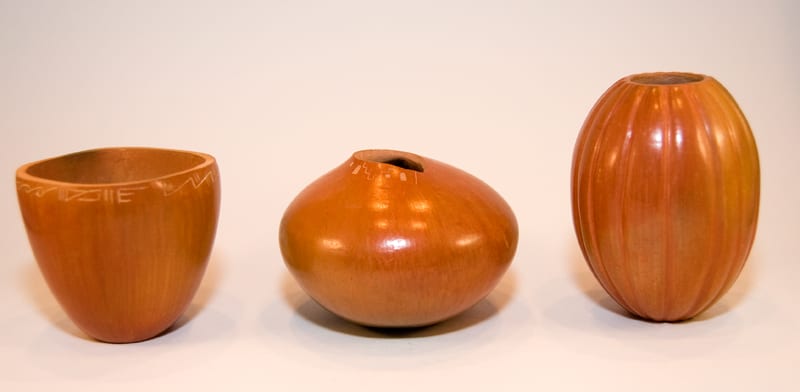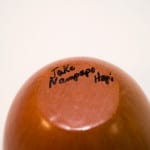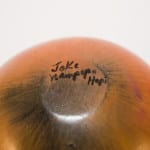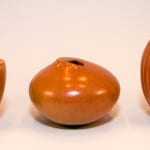2.188” h X 2.58” w; 2.31” h X 3.17” w; 3.125” h X 2.31” w, respectively
Jake (Jr.) stopped using “Nampeyo” in his signature when he was about 24 years old, in about 1994. These three small pots are not particularly well finished, and I am not aware of other undecorated “plain ware” by Jake. During an October 6, 2009 conversation in his home in Sichomovi, First Mesa (without seeing images of the pots), Jake indicated that he frequently made such small pots as models to experiment with shape and dimensions before he attempted a full-size pot. These pots, however, turned out to have a different purpose.
I was able to return to Hopi and continue this conversation with Jake six weeks later, on November 19, 2009. This time I brought images of these three small pots. Jake remembers them well and the story he told was both unexpected and significant in the history of contemporary Hopi pottery. The story necessitates a complicated journey through genealogy.
Jake is named after his father, Jacob, Senior. Jake, Jr., is descended from Nampeyo and Lesso’s fourth child Nellie and Jake represents the fifth generation of Nampeyo potters. Alton Komalestewa is descended from Nampeyo and Lesso’s third child William and Alton represents the fourth generation of Nampeyo potters, though his descent is through the male line and is thus not often recognized in the matriarchal Hopi-Tewa genealogy. To further complicate his genealogy, Alton’s father (Austin, Sr.) married a Santa Clara woman Emily Shupla and they had twelve children, all of whom were raised at Santa Clara. Like his father Alton married a Santa Clara woman, Jeanne Shupla. Though they share the same last name, mother Emily and wife Jeanne are apparently not related. Jeanne’s mother (and Alton’s mother-in-law) was Helen Shupla who was a famous maker of Santa Clara melon bowls that are distinctive because the ribs are pushed out from the inside and not carved. Mother-in-law taught son-in-law Alton this technique and he became famous making Santa Clara melon bowls that are almost indistinguishable from his mother-in-law’s. (For a small melon bowl made jointly by Alton and Jeanne, see 2011-12).
Then, tragedy. Alton’s young wife died in 1989 and within four years his father and mother-in-law also died. These deaths “left Alton devastated. He returned to Polacca and started making pottery from the clays, fuels, slips and colors of that area, which differed widely from those he had used at Santa Clara. The results were gratifying….much of his work is presently shaped and decorated in the Santa Clara tradition… (Blairs, 1999:202).”
The creation of these three small pots is a direct result of this family history. Jake says they were made about 1993, probably shortly after Alton moved to Polacca. Alton no longer had access to Santa Clara clay and was having trouble forming pots from Hopi clay. He turned to Jake for advice, although Jake himself had been making pottery for only about four years. Jake formed these three small pots as a demonstration of forms and decoration that are possible with Hopi clay. Santa Clara clay is relatively soft and can be carved and incised before firing. According to Jake, when Alton incised his Hopi clay pots before firing, the fire gave the cut surface and smooth areas the same color and the incising “disappeared.” Pots 2008-4a and 2008-4b were incised by Jake after firing to demonstrate to Alton that such decoration is possible at Hopi. The technique, however, is rarely used at Hopi because the hard clay makes the cutting difficult and increases the chances of the edge of the cut flaking off, according to Jake.
The shapes of the three jars, particularly 2008-04a and 2008-04c, are Santa Clara shapes and are not typical of First Mesa pottery. Indeed Jake says that jar 2008-04c is the only melon jar he has ever made. In effect, jars 2008-04a, 2008-04b and 2008-04c are Santa Clara pots but were made at Hopi by a Hopi-Tewa potter using local First Mesa materials and techniques. One third (?) cousin helping another adapt his potting technique to local conditions resulted in these three unique jars.
Jake says he sold these pots directly to David Griffin, the cross-country coach at the University of Minnesota. A fourth, larger and wide-shouldered bowl in this series was sold separately and is not part of this collection.
For other pots in the collection by Jake, see the Artist List.





